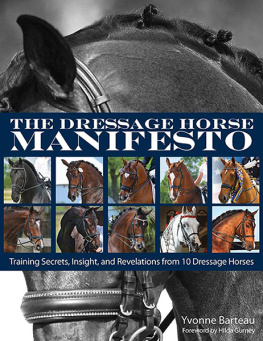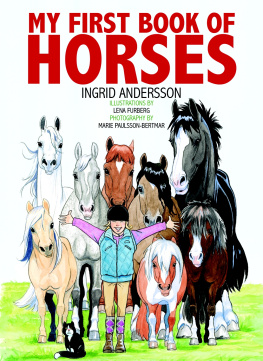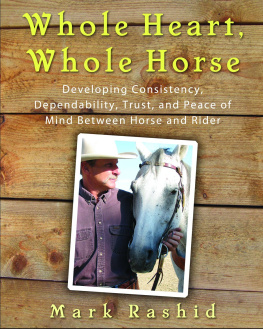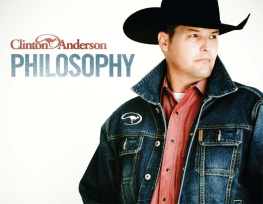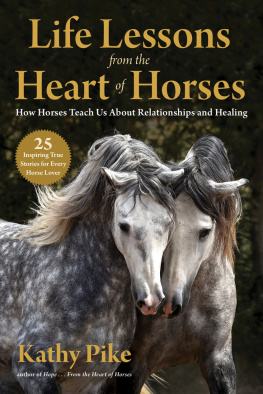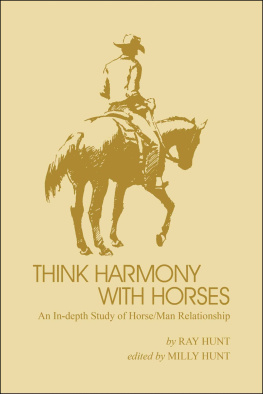horses in translation
Essential Lessons in Horse Speak:
Learn to Listen and Talk in Their Language
sharon wilsie
First published in 2018 by
Trafalgar Square Books
North Pomfret, Vermont 05053
Copyright 2018 Sharon Wilsie
All rights reserved. No part of this book may be reproduced, by any means, without written permission of the publisher, except by a reviewer quoting brief excerpts for a review in a magazine, newspaper, or website.
Disclaimer of Liability
The author and publisher shall have neither liability nor responsibility to any person or entity with respect to any loss or damage caused or alleged to be caused directly or indirectly by the information contained in this book. While the book is as accurate as the author can make it, there may be errors, omissions, and inaccuracies.
Trafalgar Square Books encourages the use of approved safety helmets in all equestrian sports and activities.
Library of Congress Cataloging-in-Publication Data
Library of Congress Cataloging-in-Publication Data
Names: Wilsie, Sharon, author.
Title: Horses in translation : essential lessons in horse speak : learn to listen and talk in their language / Sharon Wilsie.
Description: North Pomfret, Vermont : Trafalgar Square Books, 2018. | Includes index.
Identifiers: LCCN 2017059447 | ISBN 9781570768590 (paperback) | ISBN 9781570769078 (ebook)
Subjects: LCSH: Horses--Behavior. | Human-animal relationships. | Human-animal communication.
Classification: LCC SF281 .W547 2018 | DDC 636.1--dc2
3LC record available at https://lccn.loc.gov/2017059447
Book design by Tim Holtz
Cover design by RM Didier
Typefaces: Cantoria, American Typewriter, Avenir, Josefin Sans, Quorum
Front cover and back cover main photos of Apache, loved by Mackenzie Menia, Kristin Lee Photography; author photo by Francis Janik
Printed in the United States of America
10 9 8 7 6 5 4 3 2 1
This book is dedicated to the horses I have met on this journey and who continue to educate, inspire, and enlighten me as I endeavor to learn their language.
Contents
Acknowledgments
I would like to acknowledge my partner Laura for her tireless devotion to this work, and also my family and friends for all the help, love, and support they have provided. I also want to thank the wonderful and dedicated staff at Trafalgar Square Books. Furthermore, I want to say a big thank you to the horse-and-human partnerships that are the heroes and inspiration behind this book.
How do you do? Im looking forward to having this personal visit with you. Wont you sit down, and relax, while I deliver the master keys for unlocking the secrets for achieving your dreams?
Napoleon Hill, Author ofThink and Grow Rich
Part One
read this first
Chapter 1
Introduction
Since my first book Horse Speak: The Equine-Human Translation Guide was published, I have had the opportunity to meet and work with hundreds of people and horses from all over the world. My fluency in Horse Speaka practical system for listening and talking to horses in their language, instead of expecting them to comprehend ourshas deepened, but so has my understanding of what horses are usually the most confused about.
This book is dedicated to those horse lovers who are tirelessly trying to improve not only their relationship with their horses, but also with themselves. When you begin to have conversations with horses, they begin to converse with youand most of what they are trying to tell people is that they wish their humans would feel the same sense of deep well-being that they as horses are capable of.
Time and time again I have witnessed horses at a clinic finding or returning to what I call Zerothe state of being present in the moment, being aware and calmthen turning around almost immediately and offering to share this newfound confidence with not only their owners, but every person in the arena. Be they Minis or Shires, breeding stallions, yearlings, or ancient school horses still depended on for their surefooted care, all cases have demonstrated horses whose first inclination is to offer a beautiful connection back to their humans as soon as they can.
Frequently, people have pulled me aside after a clinic to utter their amazement at the seeming simplicity of the conversations they are now having with their horses. Thats it? It seems soeasy are words I have heard hundreds of times.
Learning Horse Speak takes time in the same way that learning any new language takes time. A new language is not only about word equivalences. Becoming truly fluent in another language means you must also understand the nuances, subtle meanings, and even the feel of the words implications. Language represents each individuals point of view, expresses what is valued, and demonstrates emotional preferences. This is also true for Horse Speak.
I often equate Horse Speak to the skills required to drive a car: You must use all your body parts to drive a car. Your field of vision must be trained to scan the road itself, the areas on each side of the road, and any and all signs. You are expected to interpret dozens of even more subtle things. Yet, to seasoned drivers, all of this has become so commonplace that we can also talk to our passengers or tune in our radio without a second thought. Similarly, I have been guilty of carrying on a conversation with a horse at a clinic, only to be halted by the audience, who lost the gist of the dialogue. But it can become so familiar to you that, like me, you lose yourself in wonderful, interesting, often eye-opening discussions with your horse.
Who Are You?
If you are reading this book, then you are a seeker. The horse that inspired you to take this path could be a scared-to-death rescue you just want to do right by or a soured, angry horse you hope to restore to sanity. Possibly it is your favorite riding horsemaybe he seems okay in general but leaves you with a nagging feeling that you are missing something. Perhaps you are just the type of person who always wants to go deeper and know more, or you are a professional who wants to have a better handle on the needs of your four-legged clients. You may have run the gauntlet of trainers, probably even learning valuable lessons along the way, yet still you remain dissatisfiedunfulfilled in some elusive way.
In working with hundreds of horse-human combinations, I can safely say that what is missing always revolves around one simple thing: understanding. Most people have a certain level of understanding when it comes to specific elements of horse care and horse training, and some people may be enjoying a certain amount of success with horses and with riding, but often The Gap still shows upand then here you are, reading another book, seeking answers.
The Gap
What is The Gap? It is that nagging zone between what we know and what we dont know when it comes to horses.
Most people have some level of intuition, common sense, and just enough feel to get the job done. I was one of these, with sufficient awareness and skill to get the job done for quite some time. I was doing good work, teaching Equine Assisted Learning and riding lessons at a college for students with learning disabilities. I was also the intercollegiate coach there for about four years. I had enough of the right stuff to carry a workload of private clients who varied from dressage and hunter-jumper riders to those who preferred Western pleasure to some who just wanted to trail ride barebackeven a few who drove. I worked with blind horses and horses that had suffered major head trauma, as well as starvation, abuse, and neglect cases. I taught volunteer trainings at local rescues and therapeutic riding centers, finding meaning in working with horses and riders who were often considered the toughest cases.




